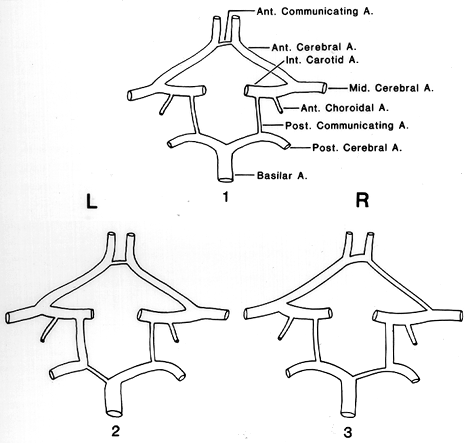

Illustrated Encyclopedia of Human Anatomic Variation: Opus II: Cardiovascular System
Ronald A. Bergman, PhD
Adel K. Afifi, MD, MS
Ryosuke Miyauchi, MD
Peer Review Status: Internally Peer Reviewed

1: "Normal circle of Willis. It is complete, symmetrical and has thread-like communicating arteries.
2: Anomalous circle of Willis. It is complete but asymmetrical due to fetal trifurcation of the left internal carotid artery and normal bifurcation of the right internal carotid.
3: Anomalous circle of Willis. It is complete but asymmetrical due to anterior trifurcation of the left internal carotid artery and reverse bifurcation of the right internal carotid.
There are 2 relatively common, variations from the normal pattern of branching of internal carotid artery. One is the persistence of the fetal pattern of trifurcation in which all 3 of the ipsilateral major cerebral arteries arise from the internal carotid while the posterior cerebral segment of the circle continues, as in the early fetus, to be a small, threadlike, posterior communicating type of vessel [B]. In the other common variation the artery divides into the middle cerebral artery and an unusually large anterior cerebral branch. The latter in turn, divides at the anterior pole of the circle into both anterior cerebral arteries. This pattern of terminal branching of the internal carotid artery has been termed anterior trifurcation [C]. The proximal part of the branch to the opposite side is oriented in the manner of the usual anterior communicating artery but is several tirnes larger. It usually is connected to the opposite internal carotid by a hair-like, communicating type of vessel. The opposite, anterior cerebral segment of the circle, however, may be missing, in which case the contralateral internal carotid simply continues as the middle cerebral artery or may bifurcate into the posterior cerebral artery and the middle cerebral artery [C].
Redrawn from Kirgis, H.D., Fisher, W.L., Llewellyn, R.C. and E. McC. Peebles. Aneurysms of the anterior communicating ar tery and gross anomalies of the circle of Willis. J. Neurosurg, 25:73-78, 1966.
Section Top | Title Page
Please send us comments by filling out our Comment Form.
All contents copyright © 1995-2025 the Author(s) and Michael P. D'Alessandro, M.D. All rights reserved.
"Anatomy Atlases", the Anatomy Atlases logo, and "A digital library of anatomy information" are all Trademarks of Michael P. D'Alessandro, M.D.
Anatomy Atlases is funded in whole by Michael P. D'Alessandro, M.D. Advertising is not accepted.
Your personal information remains confidential and is not sold, leased, or given to any third party be they reliable or not.
The information contained in Anatomy Atlases is not a substitute for the medical care and advice of your physician. There may be variations in treatment that your physician may recommend based on individual facts and circumstances.
URL: http://www.anatomyatlases.org/